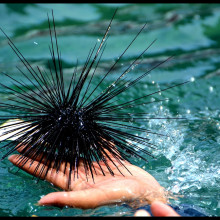Sea urchins the sea's longest lived creature, frogs croak with an accent, why people are hoarders, water fluoridation approved, allergies increase, flames in zero gravity, and special guest Prof. Chris McManus discussing "the science of left handedness".
In this episode
Frogs Croak With an Accent
I expect to most people listening to the show tonight, the croak of one frog probably sounds much the same as another. But apparently at least one species of frog has developed a regional accent in its mating calls. The finding was made by Julia Wycherley during a project to return an extinct species of pool frog to the wetlands of East Anglia. She spent a long time listening to frog calls and was convinced that she could hear subtle differences in their mating sounds. So she made recordings of the croaks and analysed the length, amplitude and volume of different calls, and found three distinct accents from Iberia, Italy and the Balkans, which is where the species was separated into distinct colonies during the last ice age. While the species was subdivided, the three main colonies seem to have begun to diverge and develop different calls. Fossil evidence has shown that the extinct East Anglian pool frogs originally came from the Balkans, so English Nature are now planning to acquire a population of Balkan frogs to try and re-establish the East Anglian population. Knowing about this subdivision of the pool frog populations from their calls means that it's very important to re-introduce absolutely the right species to East Anglia otherwise there's a risk that they won't thrive or develop a self-sustaining community.
Why Are Some People Hoarders ?
Why do some people hoard tons of junk while others can keep their lives clutter-free? Why are some people avid collectors of anything from stamps to beermats? American scientists think they have located the region of the rain that is responsible for hoarding behaviour- it's called the mesial prefrontal cortex, a tiny region found around half-way back in the brain. When they studied this region in pathological collectors, people who collect often value-less junk obsessively, they found the patients had damage to this area. Most people can discriminate between things that are worth collecting, and things that have no value. But when this part of the brain gets damaged or plays up, this discrimination is lost. Perhaps natural variations in this region could account for stamp collecting habits or even trainspotters!
Water Fluoridation Gets The Go-ahead
Water fluoridation got the go-ahead this week after members of the house of commons voted in favour of a motion enabling health authorities to force water companies top add fluoride to drinking water. Fluoride strengthens tooth enamel reducing your chances of developing tooth decay and needing fillings. Tooth enamel is made of a hard substance called hydroxyapatite which is a form of calcium phosphate. When fluoride is added to drinking water it bonds to the enamel forming a new chemical called fluoro-apatite which is much harder and more resistant to the acid attack launched by bacteria which live in the mouth. One downside of fluoride is that it can change the colour of your teeth and make them a darker colour.
Can a Flame Burn in Zero Gravity ?
When something burns, like a candle for instance, the substance acting as the fuel (e.g. the wax) becomes very hot and vapourises. Because the vapour is hot, and expands, it has a lower density than the surrounding air so it rises upwards. As it rises it mixes with oxygen in the air and the mixture burns. The hot gases produced continue to rise out of the way, and the extra heat produced vapourises more fuel so that the process can continue. But in space, where there is no gravity, there is also no density gradient so the hot gases can't rise. Instead they accumulate in place and starve the flame of a supply of fresh air, so it goes out. The only way to maintain a flame is to artificially blow in oxygen to ensure that there is sufficient to support combustion.

- Seas Longest Lived Animal - The Sea Urchin
Seas Longest Lived Animal - The Sea Urchin
Researchers have discovered the real old man or old woman of the sea – the humble sea urchin – which can live over 200 years!
Studying specimens of red sea urchins off the coat of America, marine zoologist Thomas Ebert has found that the urchins grow quite quickly as youngsters, but once they become teenagers their rate of growth slows down dramatically, but remains regular year on year.
By measuring how big a sea urchin is, you can tell how old it is. Ebert has confirmed the ages of the urchins using radio carbon dating, and some of the specimens found off British Columbia are over 19 centimetres in diameter which would make them over 200 years old.
Intriguingly, unlike humans, old sea urchins don't look their age and are also more fertile and produce more eggs and sperm than their younger counterparts.
Previously scientists thought that sea urchins lived for only 5-7 years but the more detailed understanding we now have thanks to this new study will help us to ensure their survival for much longer!

Allergies on The Increase
We are becoming a more allergic nation- that's the news from the British Medical Journal which published a study this week looking at hospital admissions for allergy-related illnesses from 1990 to the year 2000. Researchers in London found a dramatic rise in the number of serious allergic reaction resulting in a trip to casualty. The biggest rises were seen in food allergies and in anaphylaxis- a major allergic reaction to things like latex or bee stings. There was a roughly six-fold increase in the number of people going to hospital for these conditions in 2000, compared to 1990. The researchers who did the study think that we may be exposed to more things in our environment that could trigger allergies. For example food production methods may lead to inclusions of nuts in many supposedly nut-free foods. We could also be becoming more susceptible to allergies as a population, but the researchers are not sure what could be causing it.










Comments
Add a comment